KEY POINTS FROM THIS ARTICLE
— The longest running House bellwether is a rural, conservative portion of Ohio.
— If Democrats win the House, that streak and some other House bellwether streaks will likely be snapped.
— The newest bellwethers might be in the Philadelphia suburbs, Northeast Pennsylvania, and Upstate New York.
The places that vote for the House majority party
What is the historical bellwether House district? Finding out is harder than it appears. Unlike other bellwether entities like states and counties, the borders of congressional districts are frequently changed. Since the 1960s and following key Supreme Court decisions involving population equality among state and federal district lines, U.S. House district lines have shifted in every state at least once per decade (in states with more than one district) and in many states it has occurred more often than that. Moreover, districts frequently change their numbers — Nancy Pelosi (D) has represented California’s 5th, 8th and 12th congressional districts over the course of her career even though the actual area she represented (the bulk of the city of San Francisco) has remained largely unchanged.
So I’d rather look at determining the areas that have sent a member of the majority party to the House of Representatives for the longest period, regardless of the district number. This inquiry is aided by the fact that control of the House of Representatives during the last 74 years has been remarkably stable. From 1955-1995, Democrats controlled the House, and since 1995 Republicans have controlled it, with the exception of 2007-2011. So we should start with the seats that flipped in both the 2006 and 2010 elections.
There are 14 such districts. Two of them, the old Florida 22nd and New Hampshire 1st, have seen Democrats represent their entire former polity at least once since the 2010 elections, while Democrats had represented Indiana’s 9th district earlier in the 2000s. That leaves portions of at least 11 districts that have voted for a member of the House majority consistently since at least 1994.[1]
Before we get into each individual district, a word on the maps that I am posting. I used Dave’s Redistricting App, which is easy to use and is very helpful for drawing old congressional boundaries. However, it is difficult to split precincts in the application, so some of them may not reflect exact historic lines, even though any deviations from actual lines involve negligible numbers of voters.
OK, let’s begin!
Ohio’s 18th District: Bellwether since 1954
If you want to know which congressional seat has been the longest consistent bellwether, the answer is one that no longer exists. Ohio’s 18th District was represented by Democrats Wayne Hays and Doug Applegate (not to be confused with the much more recent California congressional candidate) from the start of the time period in question (1955) all the way to 1994, Republican Bob Ney from 1995-2006, Democrat Zack Space from 2007-2011, and Republican Bob Gibbs from 2011-2013. It ceased to exist when Ohio lost two seats in reapportionment after the 2010 census, leaving the state with 16 districts.
But the geographical area that made up the 18th District still exists, of course. It was based in east central Ohio and was represented by moderates when Democrats were in the majority and conservatives when Republicans were in the majority. The map below shows the areas of the old 18th that have voted in the majority for the longest. Explanations for what the colors mean come after the maps:
Map 1: East Central Ohio
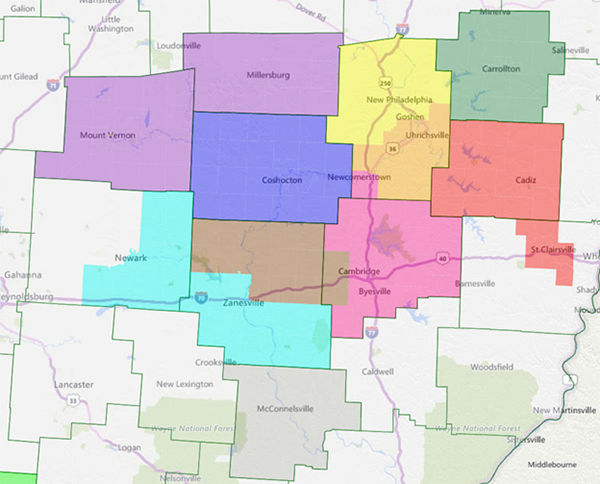
Map 2: Ross County inset

OK, I know these maps aren’t self-explanatory, so here’s a rundown of what each color means:
Red: Portions of current Sixth District that have voted for a majority member of Congress since Democrats took control of the House from Republicans in 1955. This tiny area in Harrison County and the portion of Belmont County around St. Clairsville is America’s foremost House bellwether.
Orange/Yellow: Areas that have voted for a majority member of Congress since Tuscarawas County was put into the old 18th District after mid-decade redistricting in 1967. The orange portion is in the current 6th District while the yellow portion is in the current 7th District.
Green: Carroll County, now part of the 6th District, which has voted for a majority member of Congress since 1969, when it was moved into the 18th District after another round of mid-decade redistricting.
Pink: Portions of the current 6th District that have voted for a majority member of Congress since it was put into the 18th District in 1973.
Blue: Coshocton County, now part of the 7th District, which has voted for a majority member of Congress since it was put into the 18th District in 1983.
Violet, Brown, Cyan and Gray: Areas that have voted for a majority member of Congress since they were added to the 18th District in 1993. The violet portions are now in the 7th, the Brown in the 6th, the Cyan in the 12th, and the Gray in the 15th.
Ross County Inset: The highlighted portions of Ross County have voted for a majority member of Congress since 1994, when they were represented by Rep. Dave Hobson (R), then moved to Ney’s district in the 2000 round of redistricting. The green areas are currently in the 15th District while the black section of Chillicothe is in the 2nd District.
So there are bellwether areas spread across Ohio’s 2nd, 6th, 7th, 12th, and 15th Districts. So if Democrats take over Congress, will any of them remain bellwether areas? Well, Democrats don’t appear to be seriously contesting the 2nd or the 6th this year. They do have credible candidates in both the 7th and 15th, but the sizable Republican lean of both means it’s possible they could retake the House without winning either. Still, if Democrats do manage to win the 7th and the House majority along with it, it will mean the upper half of Tuscarawas County will be America’s foremost House bellwether area. That district is rated Likely Republican in the Crystal Ball ratings.
The 12th, on the other hand, only narrowly sent now-Rep. Troy Balderson (R) to Congress in an August special election, beating Franklin County Recorder Danny O’Connor (D) by less than one percentage point. While it’s possible that O’Connor could win in November, it may be tougher for him than in the special election. In the November general election, Republican turnout will presumably be greater than in a summer special when the most energized voters were most likely to turn out (a group that leans left in 2018). Still, O’Connor has a shot, so the 12th would appear to be the Democrats’ best bet to pick up a bellwether seat that has a part of the old 18th.
Indiana’s 8th District: Bellwether since 1982
It’s fitting that the district formerly known as the Bloody Eighth is one of the country’s best predictors of House control. It’s voted for a member of the majority in every election since 1982, when Bloomington mayor Frank McCloskey (D) unseated Rep. Joel Deckard (R). The district earned its sanguine sobriquet in 1984, when the day after the election McCloskey apparently won reelection over Rick McIntyre (R) by 72 votes, only for a recount to show McIntyre won by 34 votes. The House, then run by Democrats, argued that the two different vote tabulation methods used by the state resulted in an inconclusive outcome and held the seat vacant while they convened a panel to determine who won it. After the (Democratic-led) panel determined that McCloskey had won by four votes, House Republicans stormed out of the chamber in anger.
In spite of the district’s competitiveness, McCloskey served until 1995, when John Hostettler (R) unseated him. Hostettler in turn served until 2007, when he lost to Brad Ellsworth (D) by a convincing 62-38 margin. Ellsworth only served for two terms before he left to run for the Senate, and Rep. Larry Bucshon (R) has held the seat ever since.
Below you can see the bellwether portions of the 8th, which includes the southwestern edge of the state along with the cities of Terre Haute and Evansville (Bloomington was moved to the 9th District in the 2000s).
Map 3: Bellwether Indiana
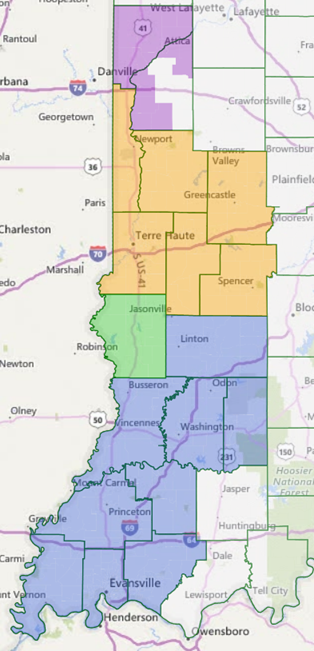
The blue portion has been in the Bloody Eighth since McCloskey initially won election. The green part (Sullivan County) was added in 1992, while the orange and purple portions have voted with the majority since 1994 but were part of the old 7th district until the 2002 round of redistricting (the orange portion is still in the 8th but the purple portion is now in the 4th).
So will the Bloody Eighth remain a bellwether? Not if the Democrats win back the House. Democrats are targeting the 2nd and 9th Districts in the state, but the 8th (and 4th for that matter) is pretty low on their hit list. So there’s a decent chance of the second longest bellwether streak snapping as well if the Democrats win the House majority.
Arizona’s 5th District: Bellwether since 1992
Fast-growing Arizona has nine congressional districts today (and will likely get a 10th in the next round of reapportionment), but back in 1993 it had a 6th member for the first time. That member was Rep. Karan English (D), who only lasted for one term before being ousted by news anchor J.D. Hayworth (R). The bombastic Hayworth lost to former Tempe Mayor Harry Mitchell (D) in 2006 (it’s always tough running against a guy who has a statue of himself in your district), but Mitchell was unable to retain the seat in the 2010 Republican wave, when he lost to David Schweikert (R).
The 5th had become swingy, as its southern portions in Phoenix and Tempe were moving to the left. But in the last round of redistricting those areas were put in a new seat, AZ-9, that Kyrsten Sinema (D) won (she’s now running for the Senate and Democrats are favored to retain her seat). Meanwhile, the more Republican parts of the 5th in Scottsdale and the north of Phoenix were put into a conservative seat (now the 6th — Arizona seemingly renumbers its seats at random to the consternation of political scientists everywhere) that’s still represented by Schweikert. Below you can see the bellwether portions of the seat in the map of eastern Maricopa County.
Map 4: Eastern Maricopa County
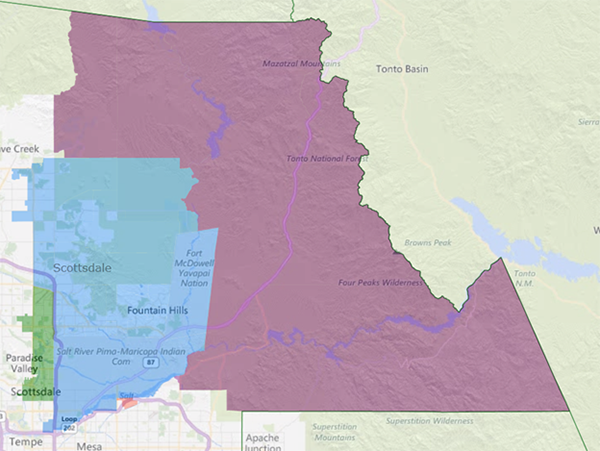
The blue, purple, and red portions of that map have been bellwethers since 1992, while the green portion has been since 1994. The purple and red portions are lightly populated areas in the safely Republican 4th and 5th Districts, but the blue portion, still in Schweikert’s district, is where the bulk of the population in this map resides.
The 6th went from backing Romney 60%-39% to only supporting Trump 52%-42%. Moreover, Hiral Tipirneni’s (D) surprisingly strong performance in the neighboring (and more conservative) 8th District’s special election shows that Democrats may have a chance here in a wave. And with an ethics investigation pending against Schweikert this race could bear watching, which is why it’s rated as Likely Republican by the Crystal Ball. But ultimately Schweikert is still the favorite against Democratic nominee Anita Malik.
So if you live in Scottsdale, Evansville, or St. Clairsville congratulations: you’re one of the few people who lives in an area that’s been a House bellwether for more than 25 years. However, if Democrats win back the House, they’ll likely do it without you. In such an instance, what areas would become the new House bellwethers? There are still remnants of eight further seats to examine:
Pennsylvania’s 10th District
The most likely bellwether area to flip back to Democrats in 2018 is, kind of, already in Democratic hands. The Pennsylvania Supreme Court’s mid-decade redistricting decision means that, come next January, bellwether areas that were put into Republican-leaning districts will almost certainly be represented by Democrats.
One such area is in the remnants of the old 10th District, which historically took in much of Northeast Pennsylvania. Republican Joseph McDade held the seat from 1963-1999, so until 1995 it was represented by a member of the minority. But when McDade retired, Republican Don Sherwood only beat Patrick Casey (brother of current Democratic Sen. Bob Casey) by narrow margins in 1998 and 2000. So in 2002, Republican line-drawers excised much of Democratic Lackawanna County (home to Scranton) to shore up Sherwood.
But Sherwood could only be shored up politically for so long. In 2005, it was discovered that the congressman had been carrying on an affair with a woman 35 years younger than him who had also accused him of abuse. He tried to win reelection in spite of the affair but he lost the seat to Chris Carney (D) 53%-47%, even though George W. Bush had won the 10th by 20 points just two years prior. Carney then managed to hang onto the seat 56%-44% even as Obama lost it 54%-45%, but the 2010 wave was too much for him as Tom Marino (R) beat him 55%-45%.
The already Republican 10th was made even more so in the next round of redistricting, but the portions of the 10th that had voted for Carney from 2006 and 2008 but otherwise supported Republicans since 1994 were split by the state supreme court’s redistricting ruling.
Map 5: Northeast Pennsylvania
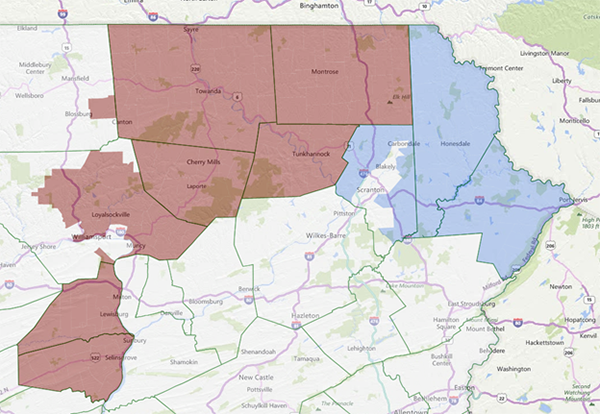
The western two-thirds of those areas are now in the reliably conservative 12th (the Supreme Court also renumbered its map), but the eastern portions in Lackawanna, Pike and Wayne Counties were put into the 8th, where incumbent Rep. Matt Cartwright (D), who’s from the portion of Lackawanna that was excised from the old 10th by mapmakers, is running for re-election. The district went from backing Obama 55%-43% in 2012 to supporting Trump 53%-44% in 2016, but Democratic strength downballot didn’t diminish by as much and Cartwright is a favorite to win.
Pennsylvania’s 7th District
Southeast Pennsylvania was a longtime Republican stronghold, and Republican Curt Weldon represented Delaware County-based 7th District from 1986-2006, the last 12 years of which were in the majority. But the district, which voted for John Kerry in 2004, was slipping away from Weldon and when in October 2006 voters discovered that he was under FBI investigation, that was it for the incumbent. The seat was held by Democrat Joe Sestak for the next two terms before his first failed Senate run.
In 2010, now-former Rep. Pat Meehan (R) was carried to victory by a Republican wave, won re-election three times in one of the ugliest gerrymanders in the country, then had to resign in disgrace. Portions of the old 7th were put in the neighboring 6th after the 2012 round of redistricting, retaining Republican representation.
Below you can see the portions of the old 7th that, other than during Sestak’s tenure, have voted for a Republican member of the House since 1994.
Map 6: Main Line Suburbs
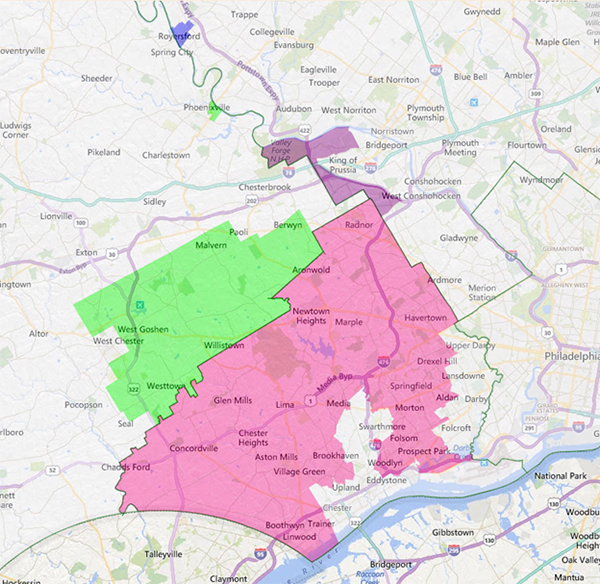
The pink portions were in the 7th from 2012-2018 and will be in the new 5th from 2018-2022.The purple portions were in the 7th from 2012-2018 and will be in the new 4th from 2018-2022. The green portions were in the 6th from 2012-2018 and will be in the new 6th from 2018-2022. The blue portions were in the 6th from 2012-2018 and will be in the new 4th from 2018-2022.
Democrats are favored to win each of the new 4th, 5th and 6th districts in 2018. So if they retake the House, all of these districts will likely be bellwethers. But thanks to Meehan’s resignation, the areas in the old 7th may not retain that distinction. A special election to fill the remainder of his term under the 7th’s old lines will be held on Election Day, simultaneous with the contests to send representatives to Congress for 2019-2021. So if Democrat Mary Gay Scanlon wins the special election, she will serve two months in Congress as a member of the minority, snapping those areas’ bellwether streak regardless of who takes control come November. The old 7th was a swing district, narrowly voting for both Romney and Clinton, and I suspect it will still vote for a Democrat in November as it seems unlikely Republicans put much effort into winning it again. So it seems likely that only the blue and green areas of that map have a chance at remaining bellwethers.
Pennsylvania’s 8th District
Democrat Patrick Murphy’s 2006 upset of freshman Rep. Mike Fitzpatrick made him the first Iraq War veteran to win a seat in Congress. He then held the seat for two terms before Fitzpatrick beat him in a rematch. Prior to his loss Fitzpatrick had taken over from Republican Jim Greenwood, who had represented the 8th since 1992. So the 8th has been a bellwether since 1994. Fitzpatrick’s brother, Brian, now holds the seat after taking over in the 2016 election.
An undivided Bucks County has been the population center of a congressional district since 1953, so tracking the 8th’s bellwether streak is far easier than most other entries here. From 1994-2018 it has been paired with various portions of Montgomery and Philadelphia Counties, but it has remained the sole constant in the old 8th (now 1st) congressional district. Below is a map of the area that has voted for a member of the House majority since 1994.
Map 7: Bucks County
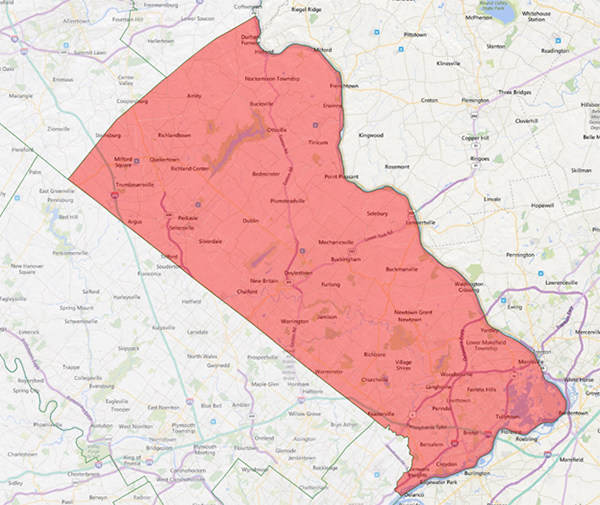
Man, why couldn’t they all be that easy? Anyway, unlike the other districts mentioned so far, the successor to the 8th (the 1st) is actually a bellwether. It narrowly went for Clinton but is represented by a Republican and is currently rated a Toss-up. The Bucks County House seat has often been competitive, switching party control in 1976, 1980, 1982, 1992, 2006, and 2010.
New York’s 19th, 20th and 24th Districts
In 2006 Democrats’ path to the majority went through Upstate New York as Democrats John Hall, Kirsten Gillibrand, and Michael Arcuri won three contiguous seats stretching from the New York City suburbs to the Finger Lakes. In 2010 Republicans’ path to the majority went through Upstate New York as Republicans Nan Hayworth, Chris Gibson, and Richard Hanna won those seats back.
Those districts included substantial swaths of area that had been in Republican hands since 1994 and haven’t flipped back since 2010. So they all remain bellwethers heading into 2018.
Map 8: Upstate New York
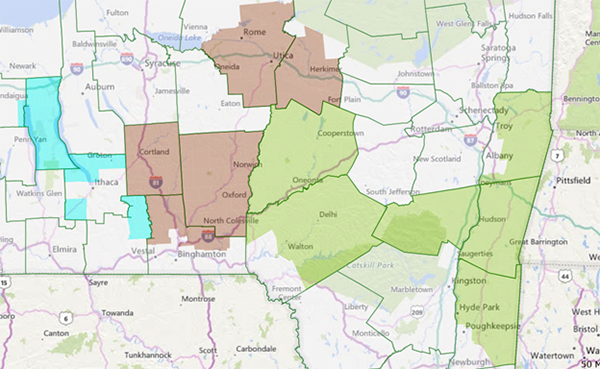
The gold areas are in the new 19th District, which voted for Obama twice but went for Trump by 4 points. Polling has shown Democrat Antonio Delgado neck and neck with freshman incumbent John Faso. The brown areas are in the new 22nd District, which voted against Obama by less than a percentage point twice but then went for Trump by 15%. Democratic state Assemblyman Anthony Brindisi represents a similarly conservative seat and is polling close to divisive freshman Rep. Claudia Tenney, so that race is rated a Toss-up as well. The light blue areas are in the new 23rd District, which voted for Obama in 2008 but has been solidly Republican since, and where Rep. Tom Reed (R) could be vulnerable in a sizeable wave but otherwise seems safe, though out of an abundance of caution his race is rated Likely Republican. So if Democrats retake the House, the easternmost areas on this map would likely remain bellwethers, as once again the majority appears to run through Upstate New York.
Wisconsin’s 8th District
When Rep. Steve Kagen (D) won the Green Bay-centered 8th District in 2006, he brought the seat back into the Democratic fold for the first time since 1998, when his predecessor Mark Green beat freshman Rep. Jay Johnson. So most of the seat has not been a bellwether since 1994. However, in the 2002 round of redistricting Wisconsin lost a seat and every district needed to expand, so the 8th took area from the 6th, a traditionally Republican district. The areas that went from the 6th to the 8th in 2002 (mapped below) have been represented in the majority since 1995.
Map 9: Fox River Valley

And it’s unlikely that’ll remain the case if Democrats win the House. They seriously contested the seat when Reid Ribble, who beat Kagen in 2010, retired and had a seemingly stellar recruit in Outagamie County Executive Tom Nelson (D). But he got hammered 63-35 by now-Rep. Mike Gallagher (R), doing even worse than Hillary Clinton at the top of the ticket. The seat is currently rated Safe Republican, though in a wave the electorate here is elastic enough to deliver a surprise.
Texas’s 23rd District
No state has as fraught a relationship with redistricting as Texas, which had five different maps in place from 1995-2007. Yet through that entire period Republican Henry Bonilla represented the 23rd district. However, when a federal court imposed a sixth map on him in 2006 he lost a more Democratic seat to former Rep. Ciro Rodriguez (D), who in turn held onto the seat for two terms until he lost in the 2010 wave.
The swingy 23rd then returned to the Democratic fold so, story over, no longer a bellwether, right? Not quite. In the 2012 round of redistricting a few precincts shifted from the 23rd to the neighboring 21st, which has been reliably Republican this decade (and dating back to the ‘70s for that matter). You can see those areas, which contain only 15,000 or so people, on the map below.
Map 10: San Antonio
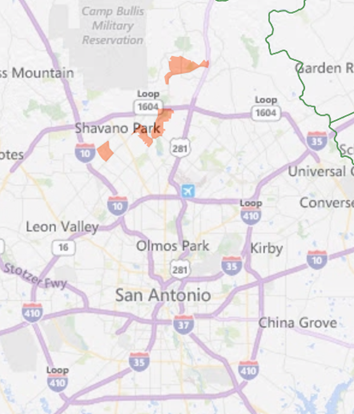
These precincts were in the 23rd from 1994-2012 and the 21st from 2012 onward. And longtime incumbent Lamar Smith (R) is retiring this year and Democrats think they have a chance at the seat, which went from supporting Mitt Romney by 22 points to supporting Trump by less than 10. There’s a chance the good people of Bexar County could be key to House control again.
And there you have it. It’s unthinkable that Democrats win a majority without seats like Pennsylvania’s 4th, 6th and 8th so at the very least there will be a bellwether dating back to 1994 once a new Congress is seated in 2019. If Republicans retain control, the people of St. Clairsville will see their streak remain intact. If not, there are plenty of candidates to be the nation’s new House bellwether.
| Robert Wheel (a pseudonym) is an attorney and University of Virginia graduate who lives in New York. He tweets @BobbyBigWheel. |
[1] A note on House vacancies. For the purpose of this exercise when a House seat is vacant I count it as occupied by the party that won the last undisputed election through the date the new member is sworn in.
